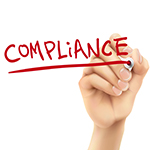Ensuring compliance with regulations and standards is essential for the smooth operation of any office. Effective compliance practices help avoid legal issues, enhance organizational efficiency, and build trust with clients and employees. Here’s a guide to best practices for maintaining compliance in your office.
Develop a Compliance Policy
Creating a comprehensive compliance policy is the foundation of effective compliance management. Your policy should outline the regulations and standards that apply to your office, including those related to health and safety, data protection, employment law, and financial reporting. Clearly define roles and responsibilities for compliance within your office and establish procedures for addressing compliance issues. Ensure that your policy is easily accessible to all employees and regularly updated to reflect changes in regulations.
Train Employees Regularly
Training is crucial for ensuring that employees understand and adhere to compliance requirements. Implement regular training sessions on relevant regulations, company policies, and best practices. This can include workshops, online courses, or in-person training. Make sure that training is tailored to different roles within your office and covers both general compliance topics and specific issues related to their job functions. Ongoing training helps keep employees informed and reinforces the importance of compliance.
Implement Robust Monitoring Systems
Effective monitoring systems are essential for tracking compliance and identifying potential issues. Implement tools and processes for regularly reviewing and auditing compliance practices. This might include monitoring financial transactions, conducting safety inspections, or reviewing data protection practices. Use software solutions to track compliance metrics and generate reports that help you stay informed about your office’s compliance status.
Establish Clear Reporting Channels
Having clear reporting channels for compliance issues ensures that concerns are addressed promptly and appropriately. Encourage employees to report any compliance-related issues or violations through established channels, such as a dedicated compliance officer or an anonymous reporting system. Ensure that there are clear procedures for handling reports, investigating concerns, and taking corrective action. A transparent reporting process helps foster a culture of accountability and ensures that compliance issues are managed effectively.
Conduct Regular Audits and Assessments
Regular audits and assessments are vital for evaluating your office’s compliance practices and identifying areas for improvement. Schedule periodic internal audits to review your compliance policies and procedures. Consider engaging external auditors for an unbiased assessment of your compliance practices. Use audit findings to address any gaps or deficiencies and make necessary adjustments to your compliance program.
Keep Up-to-Date with Regulatory Changes
Regulations and standards are constantly evolving, so staying informed about changes is crucial for maintaining compliance. Subscribe to industry newsletters, attend relevant webinars or conferences, and participate in professional associations to stay updated on regulatory developments. Ensure that your compliance policies and practices are adjusted to reflect any new or updated regulations.
Promote a Culture of Compliance
Fostering a culture of compliance within your office helps ensure that everyone understands the importance of adhering to regulations and standards. Lead by example and demonstrate a commitment to compliance in your own actions. Encourage open communication about compliance issues and recognize employees who contribute to maintaining a compliant workplace. A strong culture of compliance promotes ethical behavior and helps prevent violations.
Document and Maintain Records
Proper documentation and record-keeping are essential for demonstrating compliance and managing regulatory requirements. Maintain accurate records of compliance-related activities, such as training sessions, audits, and reports. Ensure that documents are stored securely and are easily accessible when needed. Good record-keeping practices help you track compliance efforts and provide evidence of adherence to regulations.
Address Non-Compliance Promptly
When non-compliance issues arise, address them promptly and effectively. Investigate the root cause of the issue, implement corrective actions, and monitor to ensure that the issue does not recur. Take appropriate disciplinary action if necessary, and communicate any changes to your compliance policies or procedures to your team. Prompt resolution of non-compliance issues helps prevent escalation and maintains the integrity of your compliance program.
Seek Expert Advice When Needed
Compliance can be complex, and seeking expert advice may be necessary for navigating intricate regulatory requirements. Consult with legal, financial, or industry experts to ensure that your compliance practices are thorough and up-to-date. Expert advice can provide valuable insights and help you address specific compliance challenges.
Final Thoughts
Adhering to compliance best practices is essential for maintaining a well-managed, ethical, and legally compliant office. By developing a comprehensive compliance policy, training employees regularly, implementing robust monitoring systems, establishing clear reporting channels, conducting regular audits, staying updated on regulatory changes, promoting a culture of compliance, documenting and maintaining records, addressing non-compliance promptly, and seeking expert advice when needed, you can effectively manage compliance and safeguard your office’s operations. With these practices in place, you’ll be well-equipped to navigate the regulatory landscape and foster a compliant and successful workplace.
